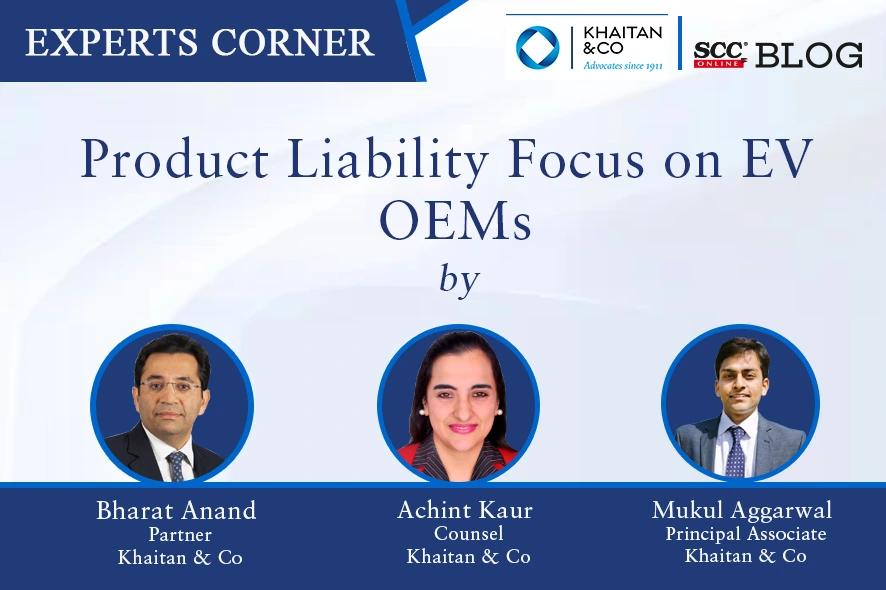Government’s favourable policies for electric vehicles (EVs) have enabled an exponential increase for EV registration, with 2022 seeing a 209%1 increase in registrations compared to 2021. However, the lure of the enabling policy framework including financial incentives should not make EV original equipment manufacturers (OEMs) oblivious to issues of product liability issues and product recall if the EVs are defective.
Consumer Protection Act, 2019 defines product liability as the responsibility of a manufacturer/seller, of any product/service, to compensate a consumer for any harm caused by such defective product manufactured/sold or by a deficiency in services thereof.
Also, as a consumer protection measure, mass product recalls may be enforced by the Ministry of Road Transport and Highways (MoRTH) against manufacturers if the defect impairs the environment, driver, occupants, road users or consumers; or the defect is reported to the MoRTH; or the product/component is faulty.
Jurisprudence on products liability is evolving globally and suffice to say that India is keeping pace with it and the Indian judiciary seems to be spearheading it. In 2021, the Supreme Court of India, in Tata Motors Ltd. v. Antonio Paulo Vaz2, held a dealer liable for a service defect and in 2023, the National Consumer Disputes Redressal Commission, held both the dealer and manufacturer jointly and severally liable for the inherent manufacturing defect, ordering replacement/refund of the vehicle price, in Shivani v. Mahindra & Mahindra Ltd.3
Globally, courts have held that defective design of lithium-ion battery must proximately cause the injury, and in US, the courts have noted that defendant’s net worth for awarding punitive damages may also be considered. California courts examining product liability in relation to complex technical issues like operation of airbags and automated driving systems do not consider the expectation of an ordinary customer from an automobile component to be a benchmark for evaluating a design defect.
To prevent reputation and economic loss, EV OEMs may consider:
(i) developing a product liability strategy and defence mechanism and improve the organisation’s ability to mitigate the risk of product recall comprising of:
(a) maintaining real-time logs of the equipment’s performance indicators (using new-age tech products like predictive battery maintenance technology) to establish whether the damage has emanated from its products/services, securing the wreckage, and storing it in a safe location for root cause analysis of the accident;
(b) integrating technology with policies and procedures, for timely detection of the product’s defects, to nip the issue in the bud; and
(c) checking the product to avoid design/manufacturing defects.
(ii) including safeguards in supply and distribution contracts, providing user guidelines/warnings, exclusions for indirect, consequential damages, combination/modification claims, limitations for defined use in terms of scope, period, recourse (sole and exclusive remedy), amount, conformance with specifications, undertaking one’s own due diligence for product application;
(iii) outlining detailed process for addressing consumer complaints, and timely resolution; and
(iv) procuring an insurance covering product liability, product recall, directors’ and officers’ liability, legal fees, medical costs, and compensatory damages, resulting from third-party product liability claims.
From the standpoint of investors in EV OEMs, they should inter alia ensure that (i) its nominees while acting as non-executive director(s) (NEDs) act diligently in the board process of the EV OEM to fulfil their fiduciary duty; and (ii) the role of NEDs is identified at the time of appointment to secure the defence that the NEDs are not involved in the day-to-day management and administration of the EV OEM; and (iii) require the EV OEM to procure D&O insurance without any exclusion for product liability/recall, business crisis management, or environmental litigation. While this may entail an enhanced insurance premium for the EV OEM, if good practices are adopted to mitigate the product liability risk, it may be possible to secure reasonable quotes for insurance premium.
With media reports of numerous electric two-wheelers catching fire last year, an investigation by the panel led by the Defence Research and Development Organisation found that defects occurred because EV OEMs used lower-grade materials4 to cut costs. Government in turn prescribed technical requirements in the form of AS-156 (specific requirements for L category electric powertrain vehicle) and AIS-038 (Rev 2) (specific requirements for M, N Category electric powertrain vehicles) to make the EVs reliable and acceptable by the masses. These norms were introduced in two phases and specify additional tests safeguarding against vehicular fires, requiring EVs to maintain smart battery management systems, include charge voltage cut-off to pre-empt overcharging and short-circuiting. Also, with the intent of safeguarding human safety of EVs, the Ministry of Heavy Industries has on 6-9-2023, made these norms mandatory w.e.f. 1-10-2023, for claiming incentives under PLI and FAME II schemes. EV OEMs such as Battrixx, RAC Energy, and Mercury EC-Tech have already procured these certifications.
While EV OEMs see the increased safety norms (under AS-156 and AIS-038) as a dampener due to increase in the production cost, the slowdown may not last for long owing to the increased consumer awareness that EVs have a lower cost of ownership as compared to internal combustion engine vehicles and OEMs should take the momentary slowdown as an opportunity to tailor their internal production and marketing strategies to avoid product liability claims and build effective defences against such claims in the future.
† Partner, Khaitan & Co.
†† Counsel, Khaitan & Co.
††† Principal Associate, Khaitan & Co.
1. PIB Press Release on Electric Vehicles. It can be accessed at <https://pib.gov.in/PressReleseDetail.aspx?PRID=1947389>
4. EV fire: DRDO investigation finds serious battery defects in EVs that caught fire, 24-5-2022, Economic Times.







